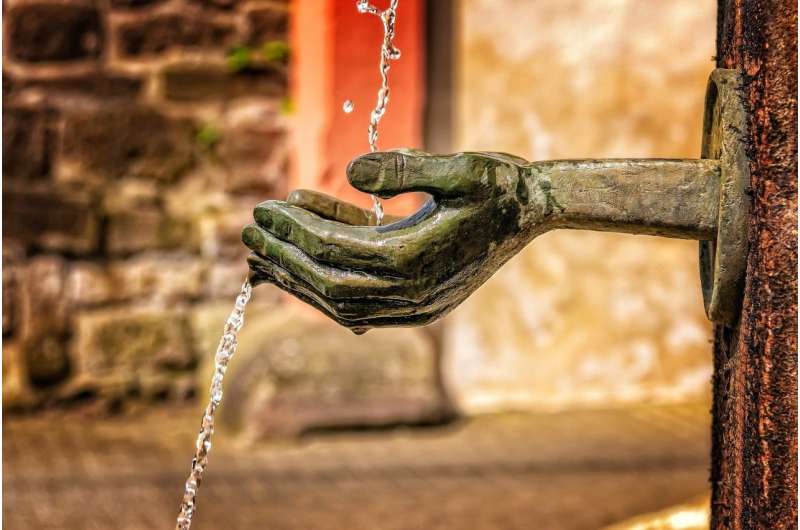This article has been reviewed according to Science X's editorial process and policies. Editors have highlighted the following attributes while ensuring the content's credibility:
fact-checked
peer-reviewed publication
trusted source
proofread
Q&A: New communication strategies to tackle climate-related water issues

Access to safe drinking water is a pressing global issue, with approximately 2 billion people currently lacking consistent access to this fundamental resource—a sobering number that is projected to soar to 5 billion by 2050. The United Nations has made global water safety—ensuring universal access to drinking water that is clean, uncontaminated and properly treated—a key priority within the Sustainable Development Goals for the millennium.
In their efforts to raise awareness about this environmental threat, researchers at USC made a surprising discovery: While investigating the relationship between water safety concerns, climate change and severe weather, they found that—around the world—people's worries about water safety were more strongly connected to their concerns about severe weather than climate change.
Findings from the study, published in the journal Environmental Science & Technology, challenge conventional approaches to environmental communication and suggest that capturing people's attention and driving meaningful action may be better achieved by framing conversations around the immediate impact of extreme weather rather than relying on messages about climate change.
USC News caught up with study authors Wändi Bruine de Bruin, Provost Professor of public policy, psychology and behavioral science at the USC Price School of Public Policy and the Department of Psychology at the USC Dornsife College of Letters, Arts and Sciences, and Joshua Inwald, a USC psychology doctoral student and first author of the study.
Why does extreme weather resonate with people more than climate change?
Bruine de Bruin: It's easier to see how severe weather threatens water safety. People can witness these events happening and understand how they might impact them personally, whereas climate change is a more abstract concept that is challenging to observe directly.
Inwald: Right. When it comes to the public's understanding of science and acceptance of climate change, we have observed that while most people now recognize climate change as a threat, they are more inclined to acknowledge the local impacts of severe weather. They readily notice changes in rainfall patterns, increased heat waves or less intense winters in their own lifetimes and local areas.
What surprised you about the study findings?
Inwald: Our results were remarkably consistent across different regions of the world. By analyzing countries based on their economic development and the state of their water infrastructure, we consistently observed that worries about severe weather had a stronger predictive power for water safety concerns than individual concerns about climate change. These patterns held true across all groups of people, regardless of the statistical techniques we used during our analysis.
What makes this study unique?
Bruine de Bruin: Most studies on public concerns about environmental risks tend to be conducted in the United States, Europe and other high-income countries. Ours draws from the Lloyd's Register Foundation's World Risk Poll. This comprehensive data set asked participants from diverse populations to report on their concerns about water safety, climate change and severe weather, among other environmental issues.
Inwald: This is especially significant in the context of water safety, which is a major concern in regions outside of the U.S. and Europe. While pockets of developed nations face significant water challenges, the most immediate and pressing impacts are felt by people in developing countries. Up until now, we haven't had robust data for these important populations to show how this issue is playing out on the global stage.
What are the impacts of this research?
Bruine de Bruin: Our findings have broad implications that extend beyond water safety. They can provide valuable insights for nonprofits, policymakers and other groups working to raise public awareness and promote behaviors that mitigate different environmental threats.
Inwald: It's also important to consider that messages about water safety and other risk communications are often disseminated from the top down, usually from organizations led by individuals from high-income Western countries. This can lead to cultural misunderstandings that make it harder to communicate with diverse, global audiences. These organizations need to adopt language that aligns with how people actually perceive climate change, weather and the quality of their water supplies.
Our approach also offers a distinct advantage in the U.S., where climate change is a highly polarized issue. When climate change or the climate crisis is mentioned, it often triggers political divisions, causing a significant portion of the audience to disengage. By focusing on severe weather instead, we can bypass these political concerns and potentially reach a broader audience.
Journal information: Environmental Science & Technology
Provided by University of Southern California


















